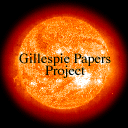 Editor's Note: Shortly before his death, Dr. Rollin Gillespie sent Viewzone a manuscript that described a theory he had been perfecting which was able to predict sunspot activity. While some of his notes required further editing, Dr. Gillespie was unable to complete this task prior to his passing. We have reviewed his correspondence and believe that it contains a significant and innovative understanding of the effects of planetary gravity on solar activity. As such, we are publishing this work as a testiment to his valuable contribution to science.
Editor's Note: Shortly before his death, Dr. Rollin Gillespie sent Viewzone a manuscript that described a theory he had been perfecting which was able to predict sunspot activity. While some of his notes required further editing, Dr. Gillespie was unable to complete this task prior to his passing. We have reviewed his correspondence and believe that it contains a significant and innovative understanding of the effects of planetary gravity on solar activity. As such, we are publishing this work as a testiment to his valuable contribution to science.
Dr. Gillespie's text appears in the blue blocks while our supplemental explanatory notes appear in the beige blocks.
by Dr. Rollin Gillespie
The writer's idea of the mechanics whereby the Sun and the planets exchange angular momentum is described for the first time. His origin and evolution of the planetary system differ radically from the textbook version. Secondly, also for the first time, is described how the angular rate of rotation of the Sun at its equator must be, and is, just twice the sum of the angular rates of revolution of all the planets. Thirdly, for the first time is described the mechanism whereby the sunspots are formed, why on the average each new cycle begins at north and south latitudes 35.9 degrees, and why the average duration of a cycle is 0.9372 times the length of the Jupiter sidereal period of revolution. Fourth, for the first time is described the leverage by which the Earth timed the retrorotation of Venus. Also for the first time, is suggested that the "strong force" postulated by nuclear physics to account for the apparent repulsion between positive and negative electric particles at close range, is in fact a manifestation of the same mechanism as that which governs the organization of the solar system. The solution for the multibody gravitational problem is described. What is the Barycenter? You've no doubt heard that Earth revolves around the sun. Well, actually, that's not quite true!
Have you heard the term "center of gravity"? It's a technical-sounding term for something pretty simple. It's the exact center of all the material (that is, mass) that makes up the object. For example, if you have a straight stick, like a ruler or yardstick, there's a place at the middle where you can balance it on your finger. That's its center of gravity.
But the center of gravity may or may not be the point that is exactly in the middle, distance-wise, of the object. Some parts of the object may be heavier (denser) than others. If you have something like a sledge hammer that is heavier on one end than the other, the center of gravity will be much closer to the heavy end than the lighter end.
To get an idea of where the center of gravity is, rest the ends of any object like the ruler or a pencil on one finger from each hand. Slowly move your fingers together without dropping the object. Your fingers will meet underneath the object's center of gravity. You can balance the object on one finger at that special place.
The actual center of gravity could be close to the surface or deep inside, depending on whether the object is flat like a ruler or a dinner plate, or "three-dimensional," like a box or a ball. And if you let the object spin (like when you throw it), it will try to spin about that point.
In the case of the Earth and the sun, both bodies actually revolve, or spin, around the very center of the mass (similar to center of gravity) between them. This point is called the "barycenter." Earth and the sun are "connected" by the gravity pulling them together. It's just like the light end and heavy end of the sledge hammer. Compared to the size of the sun, Earth is about like a flea on a cat! So the center of mass between the Earth and the sun is almost--but not quite--the very center of the sun.
In the case of a planet the size of Jupiter, which is 318 times as massive as Earth, the barycenter of Jupiter and the sun is a bit further from the sun's center. So, as Jupiter revolves around the sun, the sun itself is actually revolving around this slightly off-center point, located just outside its surface. Thus, a planet the size of Jupiter will make the sun (or any star) appear to wobble a tiny bit. This picture shows you that the center of mass and barycenter can be slightly different points. It isn't meant to be very accurate!
We can take advantage of this bit of knowledge and look for large planets in other solar systems by learning to detect this type of tiny wobble in the star's position.


